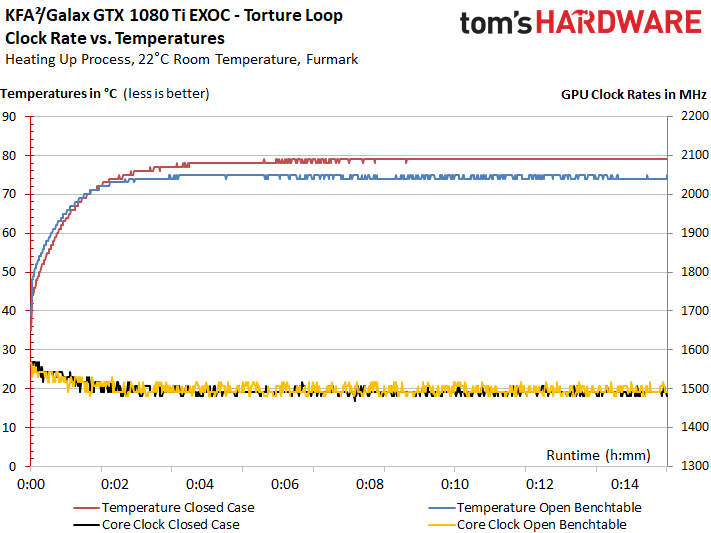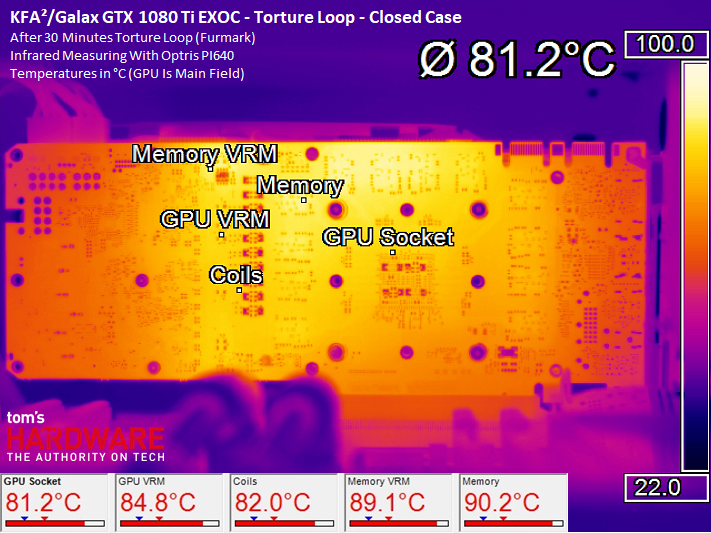KFA2/Galax GeForce GTX 1080 Ti EXOC Review
Why you can trust Tom's Hardware
Clock Rates, Overclocking & Heat
Clock Rates
Manufacturers can claim whatever they want in their marketing material. Actually achievable clock rates are subject to a number of hard-to-control variables, though. GPU quality, for instance, plays a big role, and there's no way to pre-screen what you get on that front. So, it's absolutely possible that a nominally slower card made by one board partner ends up faster than a more aggressively-tuned model from another partner. As a result, comparisons between products have to be approached with an understanding of some inherent uncertainty.
Board vendors can, however, control the settings and environmental factors that affect how GPU Boost ultimately determines operating frequency, depending on the situations it encounters. Beyond specifications like the power target or clock offset, temperature under load is perhaps the most influential factor in defining sustainable performance.
For the GeForce GTX 1080 Ti EXOC, we measured an initial GPU Boost frequency as high as 1845 MHz during our gaming loop. As the card warmed up, it maintained an average of 1772 MHz during a 30-minute measurement. This is below-average for a GeForce GTX 1080 Ti, but reasonable given KFA2/Galax's cooling performance.
During our stress test, the power limit's constraints are more palpable, manifesting as lower clock rates and, consequently, lower temperatures.
Overclocking
Of course, the card does tolerate some additional overclocking. In our case, we achieved a stable 1845 MHz under air cooling. To achieve this, we had to set the fan control to 70%, causing the card to run much noisier than its stock configuration.
If you plan to overclock, consider increasing the power target to its maximum, or at least to 110%.
The table below contains results after configuring our card in Afterburner and a long test run in The Witcher 3.
Get Tom's Hardware's best news and in-depth reviews, straight to your inbox.
| Clock Rate Increase | Power Target (Afterburner) | Avg. Boost Clock | Avg. Voltage | Power Consumption | Note |
|---|---|---|---|---|---|
| None | 100% | 1772 MHz | 0.975V | 252.1W | Original |
| None | 116% | 1845 MHz | 1.012V | 287.3W | Long-term stable |
| +70 MHz | 116% | 1911 MHz | 1.031V | 292.1W | Crash after a few minutes |
Getting a good overclock from your memory requires perseverance and a bit of luck. Seemingly stable settings might work short-term, and then prove dicey after a few hours of gaming. In the case of our sample, an extra 350 to 400 MT/s was feasible. Beyond that, performance started sliding the other direction.
Heat
We decided not to drill holes through the backplate this time around. Instead, we measured the improvement in cooling performance attributable to thermal pads. Using existing openings in the backplate as reference points, the voltage converters registered up to a 3 Kelvin-lower temperature. In the case of the GPU, we saw up to 1 Kelvin lower, at best (that's within the tolerances of our equipment). However, since the actual hot-spot is not covered by a thermal pad, we removed the backplate for our infrared readings.
No hot-spots are visible at idle, even though the fans don't spin. Clearly, this speaks volumes about KFA2/Galax's VRM heat sink implementation.
Reading from the GPU diode, we observe 77 to 78°C on an open test bench, while the PCB underneath appears similar at 77°C. The other temperatures are wholly acceptable, particularly for a high-end dual-slot graphics card.
In a closed case, the GPU temperature rises to 80°C; the package remains nearly the same.
During our stress test, the card runs even cooler since the GPU's power target limits clock rates, driving voltage down and limiting thermal output. Only the memory heats up a bit more.
In a closed case, the hottest point is found in an area around the top memory modules. However, the 90°C we measured is still acceptable for long-term use.
All things considered, KFA2/Galax's cooler shows no real weaknesses, even if it lacks the reserves to facilitate overclocking beyond 1900 MHz. The GeForce GTX 1080 Ti EXOC won't break any performance records, but it wasn't designed to. Rather, it's intended to save space and some money, while still serving up top-end frame rates.
MORE: Best Graphics Cards
MORE: Desktop GPU Performance Hierarchy Table
MORE: All Graphics Content

Igor Wallossek wrote a wide variety of hardware articles for Tom's Hardware, with a strong focus on technical analysis and in-depth reviews. His contributions have spanned a broad spectrum of PC components, including GPUs, CPUs, workstations, and PC builds. His insightful articles provide readers with detailed knowledge to make informed decisions in the ever-evolving tech landscape
-
sosofm A review about this 1080Ti http://www.kfa2.com/kfa2/graphics-card/hof/kfa2-geforcer-gtx-1080-ti-hof-le.htmlReply -
FormatC Reply
Just in work, stay tuned :)19861508 said:A review about this 1080Ti http://www.kfa2.com/kfa2/graphics-card/hof/kfa2-geforcer-gtx-1080-ti-hof-le.html
But in comparison with the dual-slot EVGA this solution is not worse. You can save a lot of money (and space), if you haven't such a big case. It is our job to show both sides of life - the Ferraris and the butter-and-bread cards. :)
-
Reply
You can tell just by looking at the pictures.19861700 said:Is it a blower design
Blowers have exactly 1 fan.
Blower fan blades are oriented such that the air will flow sideways.
Blowers have a casing that's designed to lead the air to the back of the card (out of the PC).
Not only does this card have 2 fans, the fan blade orientation clearly shows that the air will flow towards the card, and the casing is obviously open, which means the air isn't led anywhere.
So, no, it's not a blower design. -
Magnus Thunderson 2 HDMI 2.0 and 2 display ports would of been a much better choice but the I do not care as can not justify spending that much on a video cardReply -
photonboy Magnus Thunderson,Reply
I don't agree. I think 3xDP makes more sense. DisplayPort is becoming the standard for monitors, and people buying expensive GPU's may want a TRIPLE MONITOR setup with an HDMI left over for a BluRay playerThere are also OTHER configurations of cards for people who have different needs. -
2ndLastjedi I just got one of these GPU's, it sits at 2038 with a +136 on core @70c and can do +500 on memory but im concerned about the memory temps. Do you think the cooler solution is going to keep the memory at a safe temp with this OC?Reply






